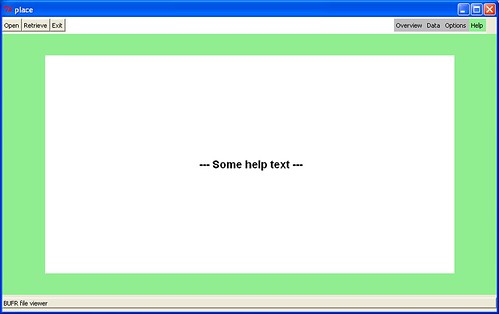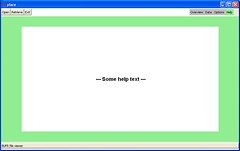place window option value ?option value ...?
place configure window ?option? ?value option value ...?
place forget window
place info window
place slaves window
place window option value ?option value ...?
Arrange for the placer to manage the geometry of a slave whose pathName is window. The remaining arguments consist of one or more option-value pairs that specify the way in which window 's geometry is managed. Option may have any of the values accepted by the place configure command.
place is the most beautiful & flexible of the Geometry managers supported by Tk. It provides support for fixed or "rubber-sheet" placement of widgets.
http://www.tcl.tk/man/tcl8.6/TkCmd/place.htm
[Any examples of how to use it, or tips on things to do or not do?]
I have an example on using place that I want to share, since it demontrates some valuable uses of this geometry manager (especially for resizing windows). I apologize for the missing commands. This script is only runnable in order to show how resizing the main window affects the buttons etc. I will clean it up later I hope. Egil
#
# Three horizontal frames stacked on top of each other:
#
set c_height 0.8
set d_height 0.8
frame .c -background white
frame .m
frame .d
place .c -relx 0 -rely 0 -height ${c_height}c -relwidth 1.0 -width -0.5c
place .m -relx 0 -y ${c_height}c -relheight 1.0 -height -[expr {$c_height + $d_height}]c -relwidth 1.0
place .d -relx 0 -rely 1.0 -y -${d_height}c -height ${d_height}c -relwidth 1.0
#
# Top frame: Command buttons (to the left) and tabs (to the right):
#
button .c.open -text "Open" -command open_bufr
button .c.getdata -text "Retrieve" -command get_data
button .c.exit -text "Exit" -command exit_app
pack .c.open .c.getdata .c.exit -side left
button .c.data -text "Data" -relief flat -bg grey -command "tabraise data"
button .c.overview -text "Overview" -relief flat -bg grey -command "tabraise overview"
button .c.options -text "Options" -relief flat -bg grey -command "tabraise options"
button .c.help -text "Help" -relief flat -bg LightGreen -command "tabraise help"
pack .c.help .c.options .c.data .c.overview -side right -fill x -expand no
#
# Middle frame: Four frames that is raised by pushing tabs above:
#
frame .m.fd -background LightGreen
place .m.fd -relx 0 -rely 0 -relwidth 1.0 -relheight 1.0
frame .m.fo -background LightGreen
place .m.fo -relx 0 -rely 0 -relwidth 1.0 -relheight 1.0
frame .m.hlp -background LightGreen
place .m.hlp -relx 0 -rely 0 -relwidth 1.0 -relheight 1.0
frame .m.opt -background LightGreen
place .m.opt -relx 0 -rely 0 -relwidth 1.0 -relheight 1.0
#
# Help text:
#
set helpfont [font create -family helvetica -size 14 -weight bold]
label .m.hlp.l -bg white -justify left -font $helpfont -text {
--- Some help text ---
}
place .m.hlp.l -x 2c -y 1c -relwidth 1.0 -width -4c -relheight 1.0 -height -2c
raise .m.hlp
label .d.messages -textvariable bottom_message -relief raised -width 200 -anchor w
set bottom_message "BUFR file viewer"
pack .d.messages -side left -expand yes
wm geometry . 1200x640+50+50See also:
Screenshots


gold added pix